Sameera Ramasinghe
University of Adelaide
Nesterov Method for Asynchronous Pipeline Parallel Optimization
May 02, 2025Abstract:Pipeline Parallelism (PP) enables large neural network training on small, interconnected devices by splitting the model into multiple stages. To maximize pipeline utilization, asynchronous optimization is appealing as it offers 100% pipeline utilization by construction. However, it is inherently challenging as the weights and gradients are no longer synchronized, leading to stale (or delayed) gradients. To alleviate this, we introduce a variant of Nesterov Accelerated Gradient (NAG) for asynchronous optimization in PP. Specifically, we modify the look-ahead step in NAG to effectively address the staleness in gradients. We theoretically prove that our approach converges at a sublinear rate in the presence of fixed delay in gradients. Our experiments on large-scale language modelling tasks using decoder-only architectures with up to 1B parameters, demonstrate that our approach significantly outperforms existing asynchronous methods, even surpassing the synchronous baseline.
VI3NR: Variance Informed Initialization for Implicit Neural Representations
Apr 27, 2025Abstract:Implicit Neural Representations (INRs) are a versatile and powerful tool for encoding various forms of data, including images, videos, sound, and 3D shapes. A critical factor in the success of INRs is the initialization of the network, which can significantly impact the convergence and accuracy of the learned model. Unfortunately, commonly used neural network initializations are not widely applicable for many activation functions, especially those used by INRs. In this paper, we improve upon previous initialization methods by deriving an initialization that has stable variance across layers, and applies to any activation function. We show that this generalizes many previous initialization methods, and has even better stability for well studied activations. We also show that our initialization leads to improved results with INR activation functions in multiple signal modalities. Our approach is particularly effective for Gaussian INRs, where we demonstrate that the theory of our initialization matches with task performance in multiple experiments, allowing us to achieve improvements in image, audio, and 3D surface reconstruction.
Scaling Prompt Instructed Zero Shot Composed Image Retrieval with Image-Only Data
Apr 01, 2025Abstract:Composed Image Retrieval (CIR) is the task of retrieving images matching a reference image augmented with a text, where the text describes changes to the reference image in natural language. Traditionally, models designed for CIR have relied on triplet data containing a reference image, reformulation text, and a target image. However, curating such triplet data often necessitates human intervention, leading to prohibitive costs. This challenge has hindered the scalability of CIR model training even with the availability of abundant unlabeled data. With the recent advances in foundational models, we advocate a shift in the CIR training paradigm where human annotations can be efficiently replaced by large language models (LLMs). Specifically, we demonstrate the capability of large captioning and language models in efficiently generating data for CIR only relying on unannotated image collections. Additionally, we introduce an embedding reformulation architecture that effectively combines image and text modalities. Our model, named InstructCIR, outperforms state-of-the-art methods in zero-shot composed image retrieval on CIRR and FashionIQ datasets. Furthermore, we demonstrate that by increasing the amount of generated data, our zero-shot model gets closer to the performance of supervised baselines.
DARB-Splatting: Generalizing Splatting with Decaying Anisotropic Radial Basis Functions
Jan 21, 2025Abstract:Splatting-based 3D reconstruction methods have gained popularity with the advent of 3D Gaussian Splatting, efficiently synthesizing high-quality novel views. These methods commonly resort to using exponential family functions, such as the Gaussian function, as reconstruction kernels due to their anisotropic nature, ease of projection, and differentiability in rasterization. However, the field remains restricted to variations within the exponential family, leaving generalized reconstruction kernels largely underexplored, partly due to the lack of easy integrability in 3D to 2D projections. In this light, we show that a class of decaying anisotropic radial basis functions (DARBFs), which are non-negative functions of the Mahalanobis distance, supports splatting by approximating the Gaussian function's closed-form integration advantage. With this fresh perspective, we demonstrate up to 34% faster convergence during training and a 15% reduction in memory consumption across various DARB reconstruction kernels, while maintaining comparable PSNR, SSIM, and LPIPS results. We will make the code available.
Learning Visual Hierarchies with Hyperbolic Embeddings
Nov 26, 2024Abstract:Structuring latent representations in a hierarchical manner enables models to learn patterns at multiple levels of abstraction. However, most prevalent image understanding models focus on visual similarity, and learning visual hierarchies is relatively unexplored. In this work, for the first time, we introduce a learning paradigm that can encode user-defined multi-level visual hierarchies in hyperbolic space without requiring explicit hierarchical labels. As a concrete example, first, we define a part-based image hierarchy using object-level annotations within and across images. Then, we introduce an approach to enforce the hierarchy using contrastive loss with pairwise entailment metrics. Finally, we discuss new evaluation metrics to effectively measure hierarchical image retrieval. Encoding these complex relationships ensures that the learned representations capture semantic and structural information that transcends mere visual similarity. Experiments in part-based image retrieval show significant improvements in hierarchical retrieval tasks, demonstrating the capability of our model in capturing visual hierarchies.
Test-Time Adaptation of 3D Point Clouds via Denoising Diffusion Models
Nov 21, 2024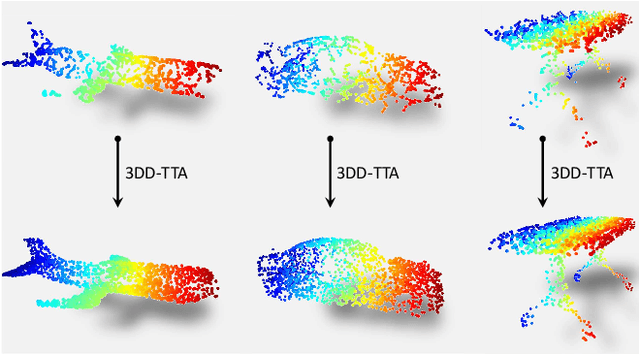



Abstract:Test-time adaptation (TTA) of 3D point clouds is crucial for mitigating discrepancies between training and testing samples in real-world scenarios, particularly when handling corrupted point clouds. LiDAR data, for instance, can be affected by sensor failures or environmental factors, causing domain gaps. Adapting models to these distribution shifts online is crucial, as training for every possible variation is impractical. Existing methods often focus on fine-tuning pre-trained models based on self-supervised learning or pseudo-labeling, which can lead to forgetting valuable source domain knowledge over time and reduce generalization on future tests. In this paper, we introduce a novel 3D test-time adaptation method, termed 3DD-TTA, which stands for 3D Denoising Diffusion Test-Time Adaptation. This method uses a diffusion strategy that adapts input point cloud samples to the source domain while keeping the source model parameters intact. The approach uses a Variational Autoencoder (VAE) to encode the corrupted point cloud into a shape latent and latent points. These latent points are corrupted with Gaussian noise and subjected to a denoising diffusion process. During this process, both the shape latent and latent points are updated to preserve fidelity, guiding the denoising toward generating consistent samples that align more closely with the source domain. We conduct extensive experiments on the ShapeNet dataset and investigate its generalizability on ModelNet40 and ScanObjectNN, achieving state-of-the-art results. The code has been released at \url{https://github.com/hamidreza-dastmalchi/3DD-TTA}.
Neural Experts: Mixture of Experts for Implicit Neural Representations
Oct 29, 2024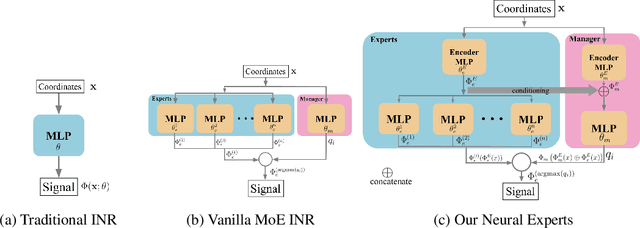
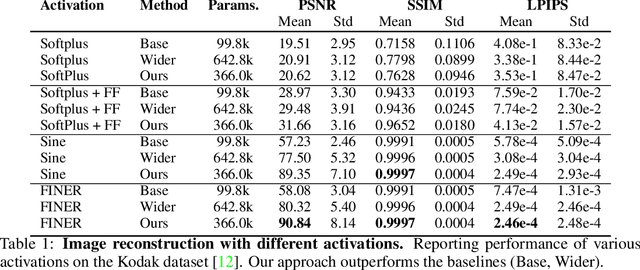


Abstract:Implicit neural representations (INRs) have proven effective in various tasks including image, shape, audio, and video reconstruction. These INRs typically learn the implicit field from sampled input points. This is often done using a single network for the entire domain, imposing many global constraints on a single function. In this paper, we propose a mixture of experts (MoE) implicit neural representation approach that enables learning local piece-wise continuous functions that simultaneously learns to subdivide the domain and fit locally. We show that incorporating a mixture of experts architecture into existing INR formulations provides a boost in speed, accuracy, and memory requirements. Additionally, we introduce novel conditioning and pretraining methods for the gating network that improves convergence to the desired solution. We evaluate the effectiveness of our approach on multiple reconstruction tasks, including surface reconstruction, image reconstruction, and audio signal reconstruction and show improved performance compared to non-MoE methods.
From Activation to Initialization: Scaling Insights for Optimizing Neural Fields
Mar 28, 2024



Abstract:In the realm of computer vision, Neural Fields have gained prominence as a contemporary tool harnessing neural networks for signal representation. Despite the remarkable progress in adapting these networks to solve a variety of problems, the field still lacks a comprehensive theoretical framework. This article aims to address this gap by delving into the intricate interplay between initialization and activation, providing a foundational basis for the robust optimization of Neural Fields. Our theoretical insights reveal a deep-seated connection among network initialization, architectural choices, and the optimization process, emphasizing the need for a holistic approach when designing cutting-edge Neural Fields.
Backpropagation-free Network for 3D Test-time Adaptation
Mar 27, 2024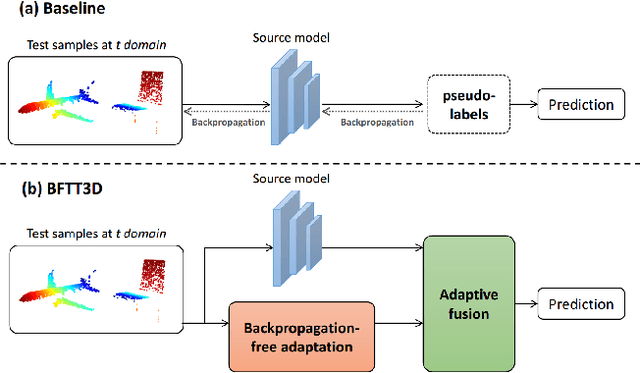

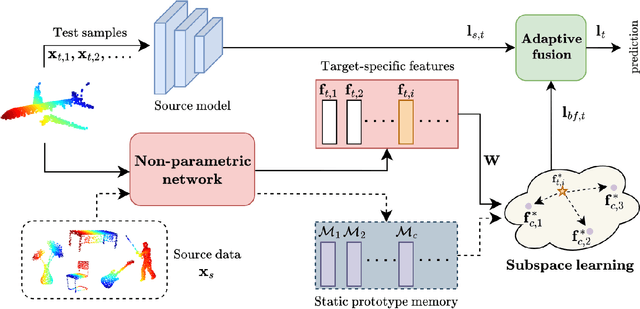

Abstract:Real-world systems often encounter new data over time, which leads to experiencing target domain shifts. Existing Test-Time Adaptation (TTA) methods tend to apply computationally heavy and memory-intensive backpropagation-based approaches to handle this. Here, we propose a novel method that uses a backpropagation-free approach for TTA for the specific case of 3D data. Our model uses a two-stream architecture to maintain knowledge about the source domain as well as complementary target-domain-specific information. The backpropagation-free property of our model helps address the well-known forgetting problem and mitigates the error accumulation issue. The proposed method also eliminates the need for the usually noisy process of pseudo-labeling and reliance on costly self-supervised training. Moreover, our method leverages subspace learning, effectively reducing the distribution variance between the two domains. Furthermore, the source-domain-specific and the target-domain-specific streams are aligned using a novel entropy-based adaptive fusion strategy. Extensive experiments on popular benchmarks demonstrate the effectiveness of our method. The code will be available at https://github.com/abie-e/BFTT3D.
ViewFusion: Towards Multi-View Consistency via Interpolated Denoising
Feb 29, 2024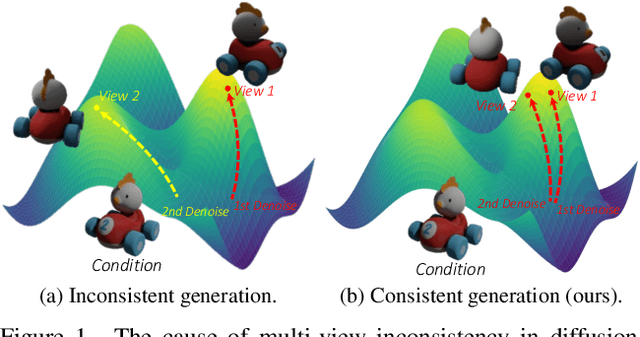
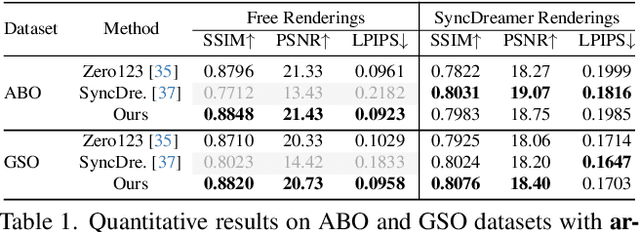
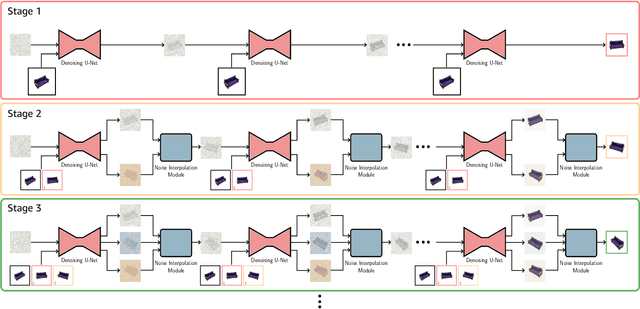
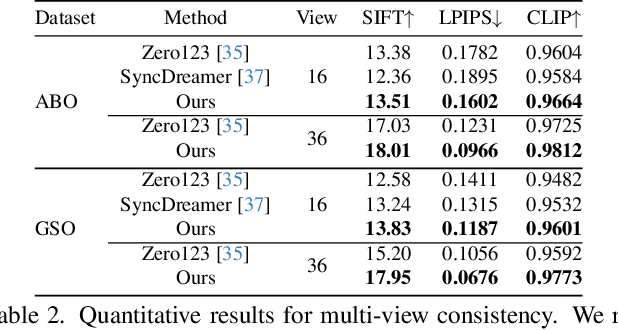
Abstract:Novel-view synthesis through diffusion models has demonstrated remarkable potential for generating diverse and high-quality images. Yet, the independent process of image generation in these prevailing methods leads to challenges in maintaining multiple-view consistency. To address this, we introduce ViewFusion, a novel, training-free algorithm that can be seamlessly integrated into existing pre-trained diffusion models. Our approach adopts an auto-regressive method that implicitly leverages previously generated views as context for the next view generation, ensuring robust multi-view consistency during the novel-view generation process. Through a diffusion process that fuses known-view information via interpolated denoising, our framework successfully extends single-view conditioned models to work in multiple-view conditional settings without any additional fine-tuning. Extensive experimental results demonstrate the effectiveness of ViewFusion in generating consistent and detailed novel views.
 Add to Chrome
Add to Chrome Add to Firefox
Add to Firefox Add to Edge
Add to Edge